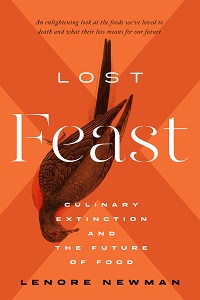
When I first heard the phrase “food security” I thought of barriers due to poverty or living in inner city food deserts without grocery stores. After a particularly wet November one year when floods closed the I-5 freeway for a few days I heard the concept also applied to the danger of our region being cut off from the food supply because trucks bearing produce from the south couldn’t get through. Lenore Newman is director of the Food and Agriculture Institute at the University of the Fraser Valley in British Columbia, Canada. Her book
Lost Feast introduces another aspect of food security — the plants and animals people consume going extinct. Newman reports humanity has lost over 90% of named vegetable cultivars, and 87% of pear cultivars: “Think of a great library of flavors. For the last century we have been burning all of the books.”
In America, the long-extinct passenger pigeon once flew in flocks so numerous that the sky could be obscured for days at a time. The birds were a symbol of the boundless abundance the new world represented and a reliable food source for Native people and for the waves of poor immigrants that poured in from abroad. But by the second half of the nineteenth century the flocks had grown so scarce that the bird was reserved for the very wealthy at fancy New York restaurants, such as Delmonico’s.
Each chapter starts and ends with an extinction dinner prepared by a friend who has a talent for cooking and a fondness for animals succeeding in human environments, like seagulls and rats. In the chapter that covers cultivated plants such as apples and pears they decide to prepare the ancient Roman dish “pears patina,” which included grated bosc pears, cumin, pepper, and honey baked with eggs. The author insisted her friend not include “garum” a fermented liquid fish ingredient the Romans would have added for some tasty funk or as Newman described it, “an essence of low tide.”
In Lost Feast we visit Hawaii, Kazakhstan, British Columbia, Iceland, Alaska, New Zealand and many more regions of the world to explore how plants and animals evolved over millennia to the cuisines we know today.
Most of us know by now that honeybees and myriad other pollinating insects are essential for most all of our favorite fruits and vegetables. Newman details the history of the human-honeybee intertwined relationship and documents why the insects are so crucial for food production. Bees are under threat from pesticides, parasites and habitat loss — if the bees disappear so will affordable fruit.
Lenore Newman has a passion for regional cuisine, love of food and an academic’s dedication to thorough research. The historic details she uncovers are never tedious or dry and the reader can trust her as an authority in food history. Her writing style is witty but also serious, as she draws the reader in with personal stories of her research journey followed with deep background information and lamentations on how much food culture has been lost already. To counter the depressing reality of food extinction Newman leaves us with the Zen Buddhist concept of wabi-sabi: “… we should love life while balancing that love against the sense of serene sadness that is life’s inevitable passing.”